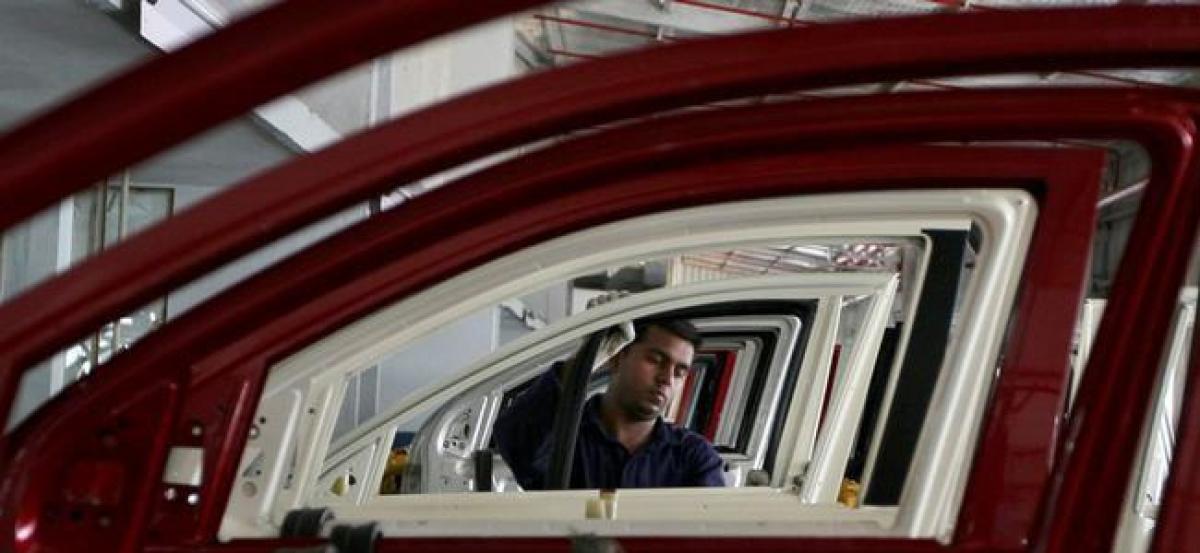Live
- India's economy in sweet spot with strong growth, inflation likely to ease: Moody’s
- Mani Shankar Aiyar questions Jaishankar's visit to Pakistan, says he created 'false hope'
- K.T. Rama Rao calls on farmers arrested for attack on Vikarabad officials
- AP CM Chandrababu Naidu Unveils Vision for Andhra Pradesh amidst Financial Challenges
- VVS Laxman lauds fans for massive support on foreign tours
- Bengal lottery scam: Huge amount of cash traced, ED brings currency counting machine
- Raj Thackeray releases MNS election Manifesto with a ‘key’ to implementing it
- Gold prices likely to further come down with no near-term positive triggers
- Tough decision, but it's the right one: Southee on Test retirement
- After caste census, Dalits, tribals, poor will recognise their true strength: Rahul Gandhi
Just In

After an 18-month review, General Motors Co is nearer to resolving a raft of issues that have hobbled its $1 billion strategy for India, one of the fastest growing emerging markets for automobiles.
DETROIT: After an 18-month review, General Motors Co is nearer to resolving a raft of issues that have hobbled its $1 billion strategy for India, one of the fastest growing emerging markets for automobiles.
The strategy, announced in July 2015, includes selling one of its two Indian assembly plants to a Chinese partner; changing its vehicle platform to provide a product line-up better suited to the local market; and making India an export hub, two Asia-based people with knowledge of the plans told Reuters in Detroit this month. They did not want to be named as the review is ongoing.
GM needs to finalize these moves to turn around its money-losing business in India, where its sales fell by more than a fifth last year to just 28,949 vehicles, taking its market share to below 1 percent.
"India is a very tough market. It's growing and has potential for the future. But you need the right recipe," one of the individuals said.
India's auto market, dominated by Japan's Suzuki Motor and South Korea's Hyundai Motor and their local partners, is widely tipped to overtake Japan as the world's third biggest by around 2020.
GM said in mid-2015 it aimed to double its India market share by 2020. But its share fell to 0.93 percent last year from 1.18 percent in 2015 - even as India's market grew 7 percent to around 3 million vehicles.
"Despite being one of the earliest entrants to India ... GM has consistently lost share. One issue is that it misunderstood what value means to Indian consumers. Value doesn't mean low price, it means having a product that has the right mix of good price and content," said Puneet Gupta, an analyst at IHS Markit in New Delhi.
"That said, GM understands the market's potential and is positioning itself for a comeback. It has already been fairly successful in exporting small cars by leveraging the frugal engineering skills of India suppliers."
PLANT SALE
The U.S. automaker is close to selling its Halol plant in Gujarat to SAIC Motor, its main Chinese joint-venture partner, the two people said, predicting a deal would be finalised this year.
"We have a defined path: we are aligned with our partner SAIC. They want to take over that plant," one of them said.
SAIC declined to comment.
Selling the Halol facility, which has annual capacity for up to 110,000 vehicles, would allow GM to consolidate and modernize its India manufacturing capability at Talegaon, about 100 km (62 miles) southeast of Mumbai, which currently can produce 150,000 vehicles a year.
The proposed sale to SAIC has dragged on, the people said, in part because of India's complex official approval process, which involves multiple stakeholders and regulators. They said a deal still needs to be approved by government agencies and the plant's labour union.
GM is also reviewing its vehicle architecture so it can be more flexible and produce a range of more competitive small cars for India, the two people said, noting a market shift from no-frills sedans and 'people movers' to crossover sport utility vehicles (SUVs).
And GM needs to "adjust to the new normal of ... low oil prices, foreign currency fluctuations and geopolitical instability" to make its operations leaner and more efficient, one of the two people said, adding this could impact the $1 billion strategy price tag.
"That's what we're looking into now; whether it will be that $1 billion or whether it will be less or more."
The shift in consumer preferences to SUVs has forced GM to re-think its product strategy, and put on hold a move to a new emerging market vehicle architecture - known internally as GEM - which it jointly developed with SAIC.
GEM remains central to product programmes for markets such as Brazil, Mexico and China, but, for India, GM is now assessing it against other options to be more competitive.
"There are several alternatives, and we are investigating right now," one of the two individuals said, declining to elaborate.
GM said in September it would launch five new models in India within two years.
The GM overhaul also seeks to capitalize on India's relatively low labour costs, and make the operations there an export hub. It has said it wants to export around 30 percent of its India output by 2025.
GM's exports from India, mainly to Latin America, rose more than threefold to 68,343 vehicles last year.
Reflecting disappointing sales of mainstream models in fast-growing emerging markets, sources told Reuters in September that Ford Motor also shelved plans to produce a new family of compact cars designed mainly for markets like India, and would ramp up exports to make the most of its two Indian plants.

© 2024 Hyderabad Media House Limited/The Hans India. All rights reserved. Powered by hocalwire.com







